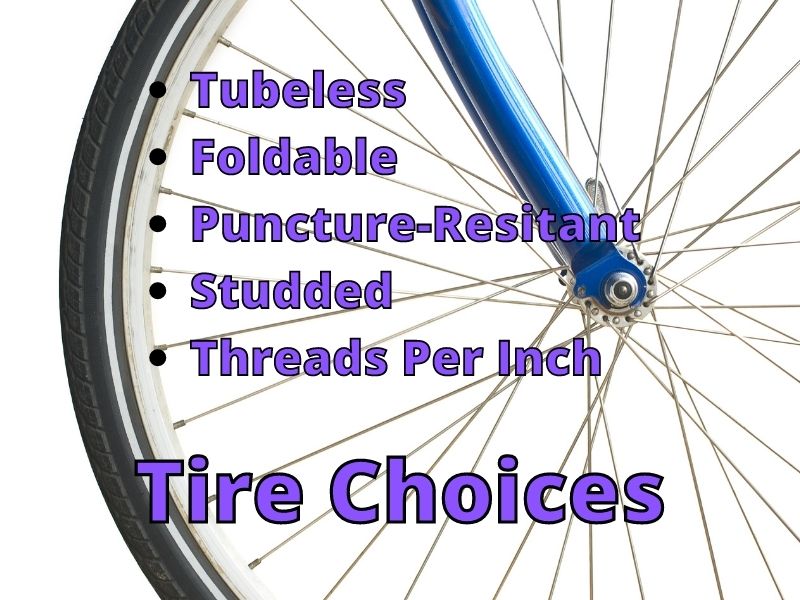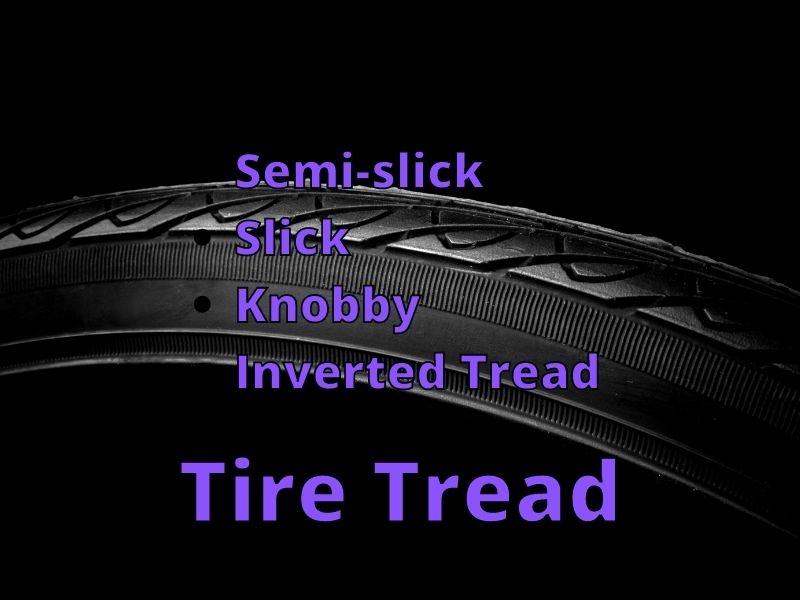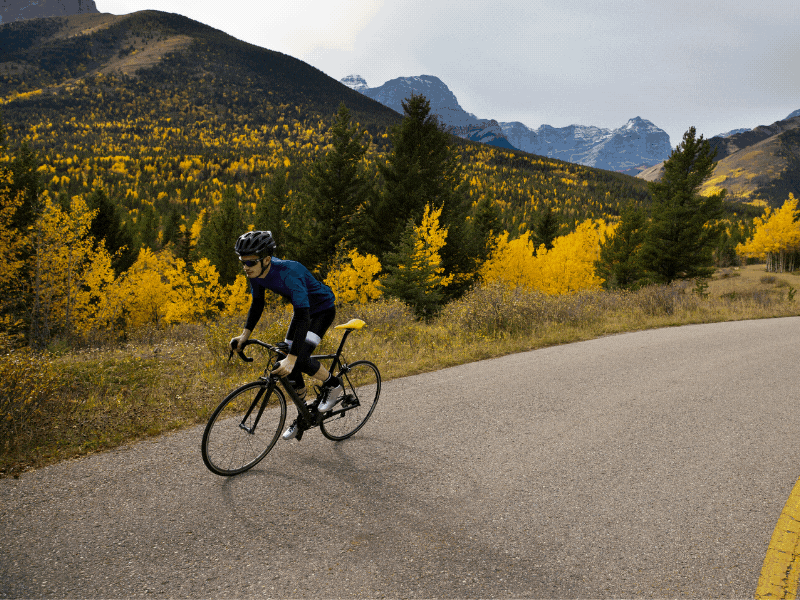Buying the correct size road bike tires isn’t always as simple as you might think. With varying sizes in tires and wheels (both in diameter and width), getting a snug fit isn’t always so straightforward.
Terms like ‘700C’, ’29-inch’, ‘622mm’, and ‘modern road bike size’ sound like different tires but can all mean the same tire size. Road bikes come in three common tire sizes. This chart correlates tire sizes and names.
| Tire Name | Width (in mm or in) | ISO (tire sizes in mm) | (rough mm or in size / tire name) | Inches (tire width influences inches) |
|---|---|---|---|---|
| Common Road Bike Tire (700c) | Standard is 23mm (sizes vary) | 622 | 700C | Varies – 29″, 28″,etc. |
| Triathalon Tire (650c) | Standard is 23mm (sizes vary) | 571 | 650C | Varies – 26×1″, 26×1 3/4″, etc. |
| Classic Road Tire | Standard is 1 1/4″ (sizes vary) | 630 | 27″ Road Tire | Varies – 27×1-1/4, 27×1-1/8, etc |
These three types of tires can fit on various bike rims. Check your current bike tire for details on the size of the tire. Then match it with a new tire. Various widths can fit on the same rim, although different tires will not. Check the ISO number to be sure you have the correct size for your rim.
The following article will give you the know-how, and inform you of the different road bike tire sizes and types, as well as which one might be best for you.
Standard Sizing System
Traditional sizing systems were a way of having a standardized size for all tires (in terms of their width and diameter), meaning that the correct size could be found with just two numbers – much like a pair of jeans!
But in more recent times, with more companies than ever producing their own road bikes and tires, almost every company has its own way of sizing tires. This was a way of prompting customers to stay with the same manufacturer under the fear that a new manufacturer’s products might not be compatible.
Road bike (see article road bikes) tire sizes can be understood in time, the only downside to this is that things are far more
confusing than they need to be!
ISO
The good news, however, is that – in an attempt to prevent this confusion – the ISO (International Organization for Standardization) came up with a system that regulates tire measurement, meaning that many new tires are required to show a simple ISO measurement – width by diameter.
Tire Width
Although the tire width isn’t as important as the diameter, it’s still a very important measurement when getting an accurate tire fit.
The wider the tire, the more contact with the road surface, and the more stability and comfort whilst riding. Having said this, narrow tires – though not as stable – offer more speed, as with less contact surface with the road, there’s less friction.
So, when trying to find the right tire for you, you need to consider both your riding style and the width of your wheel itself. 25mm is an ideal width for most as it works as a good balance between comfort and stability. Experienced riders might opt to go narrower, whilst those on rough terrain may opt to go wider.
Tire Diameter
The tire diameter is a measurement that’s the most important when getting the right fitting tire. As the outer diameter can vary based on thickness, style and treat, the BDS (bead set diameter) measures the2/15/2020 Road Bike Tire Sizes:
inside diameter within the tire.
This measurement can usually be found on the sidewall of the tire, listed in inches or mm. For example – 700 x 2.10” or 28” x 2.10”.
Tires Available on Amazon.com
There are so many different tires available that fit every type of rim or every type of tire you could need. Here are a couple of polpular tires that offer a range of sizes for the three most common tire types.
| Popular Tires on Amazon.com | Width (in mm) | ISO (tire sizes in mm) | (rough mm size / tire name) | Inches (tire width influences inches) |
|---|---|---|---|---|
| Continental Ultra Sport III (Link) | 23, 25, 28, 32 | varies | 700, 650, 27″ | Varies |
| Continental Gatorskin Bike Tire (Link) | 23, 25, 28, 32 | Varies | 700, 650, 27″ | Varies |
Features of Bike Tires

The great thing about bike tires is that there are so many options available. At the same time, this can make it difficult to choose the one that should get. Here are some options to think about before choosing.
Tubeless Bike Tires
Tubeless tires are more popular than they ever have been. Not only do these come with the benefit of no tube pinching, but with no inner tube inside, the ride is often smoother as well.
The main downside is the installation itself, as it’s a little more cumbersome and complicated – and fixing a tubeless flat can be a nightmare if you’re not well-practiced.
Foldable Bike Tires
Foldable bike tires work in a similar way to ordinary tires, but rather than a wire bead to give them a stable structure when attaching to the tire rim, they’re usually made of an aramid-fiber bead, making them foldable and compact.
The main downside with foldable tires is that they usually come with a slightly higher price tag than
normal tires.
Puncture-Resistant Bike Tires
Puncture-resistant tires are lined hardened material (usually Kevlar), making them resistant to punctures or tears. Although these are extremely handy for convenience, their heavier weight means that they’ll slow you down a little.
Studded Bike Tires
Much like car winter tires, studded bike tires contain metal studs or ‘pins’ that provide added grip and traction. These are ideal when riding in icy or snowy conditions.
Threads per Inch
Thread count is also something to consider in road bike tires. Thread count usually starts at around 60 TPI (threads per inch) but can go up to a whopping 320 TPI for the most experienced riders that want a more lightweight, performance material.
Hard and Soft Rubber Bike Tires
Depending on your experience and riding style, you might want to go for a tire with a different type of rubber. Soft rubber tires have a better grip, whereas hard rubber tires offer more speed for better performance.
Bike Tire Tread

More tread means more grip in tricky or wet terrains, but it also means more friction and resistance.
Less tread offers less resistance and therefore more speed, but also less grip. It’s important to get the right balance for where and how you’re wanting to ride.
Semi-Slick Bike Tires
Although these are mainly smooth, they do offer little tread for added grip. They’re a good balance for those looking to pick up high speed, whilst also remaining stable on the road.
Slick Bike Tires
Slick bike tires have minimal tread on them – with some modern designs having no tread at all. These are designed for riding on smooth terrains and offer the most speed of all tires. The main downside is their grip, as these can be a high risk to ride on in wet or uneven terrains.
Knobby Tires
Different styles and structures of knobby tire tread offer different performances in different situations. Taller and more protruding nobs are better for really uneven terrain such as mud or grass, whilst wider, the shallow tread is better for things like gravel.
Inverted Tread Tires
Much like semi-slick tires, inverted tread tires off some grip, whilst still offering the ability to pick up high speeds when needed. These are ideal for slightly uneven terrain, but you’ll want something more if you’re venturing completely off-road.
Front and Rear-Wheel Tire Treads
Front tires and rear tires can sometimes be designed with different treads for their different purposes when riding. Front tires are designed for taking on corners and direction, whereas rear tires are designed to make the most of the rider’s power, and for added stability.
Bike Tire Valves

There are two main bike tire valves:
Schrader Valve
Schrader valves (see article) are more standard on many bikes. They’re wider than Presta valves and aren’t as tall. These are unusual for road bikes and are more common with mountain bikes.
Presta Valve
Presta valves are the standard valve for road bike tires. They’re taller and narrower than standard bike valves (Schrader valves) and this can allow for narrower tires and wheels.
28 vs. 29-Inch Tires
This has added some confusion to the whole bike tire size thing – and left many riders wondering, what exactly is the difference?! The short answer is ‘nothing’.
Across most of Europe, 28 inches is the standard size for various bike styles, and in some bike styles, it is the most popular. Having said that, 29-inch tires were introduced a few years ago for various mountain bikes across the US.
But with the thickness of the tire taken off, these 29-inch tires, in many styles, are actually the same size as 28-inch tires. In short, 28 inch and 29-inch tires can very often fit exactly the same wheel sizes.
Advantages of 27.5 and 29-Inch Tires
Across the UK, as well as many other regions, 26 inches used to be the standard. However, in recent years, 27.5-inch tires have been introduced into the market for many hybrid and mountain bikes.
For larger mountain bikes, 29 inches was also introduced. These larger wheels offer both advantages and disadvantages. Although they’re less nimble and maneuverable, they offer better rolling speed and stability, especially on trains and uneven terrain.
The larger size also offers more contact with the terrain for better grip. The main downside with these tires is that they can’t be fitted to all bike sizes because of their large diameter.
What About Tire Wear

It goes without saying that tires wear down after use, especially on challenging terrain, when regularly braking.
Some tires last as little as 1,000 kilometers, whereas high-quality tires can last as long as ten times that, so it’s important to have an idea of how long yours will last.
Manufacturers tend to include an estimated lifespan of their tires, but depending on the terrain, weather, tire pressure, and riding style yours can last a lot longer than this.
You should inspect your tires regularly, just to make sure that they’re still safe (see riding at night article) to ride on, and still offer enough tread for the type of riding you’ll be doing. If your tire is too worn down, replace it.
Final Thoughts
Although understanding road bike tire sizes isn’t the hardest thing in the world, it certainly isn’t as straightforward as many people think.
There are various things to consider – weight, style, material, tread, etc. – and this can initially seem overwhelming.
The best thing to do is to strike a balance in order to find something that offers good performance, whilst keeping you safe (see foot placement article) and stable when out on a ride.
Thanks for visiting Helpshoe.com

